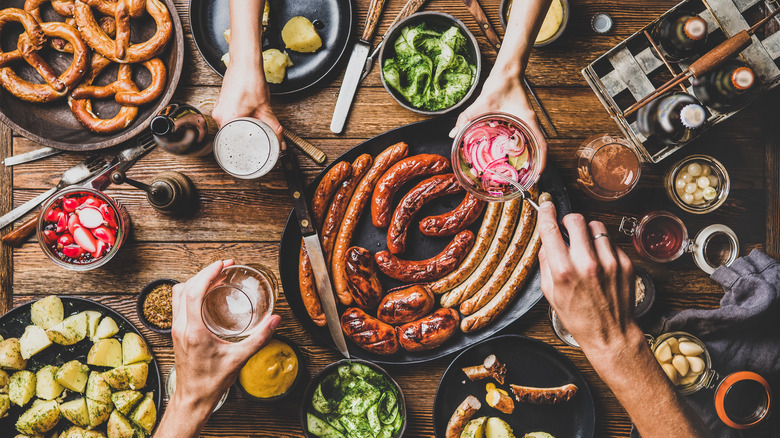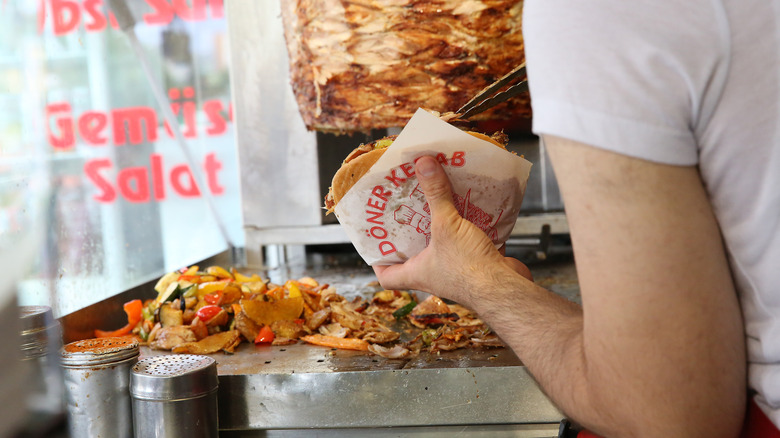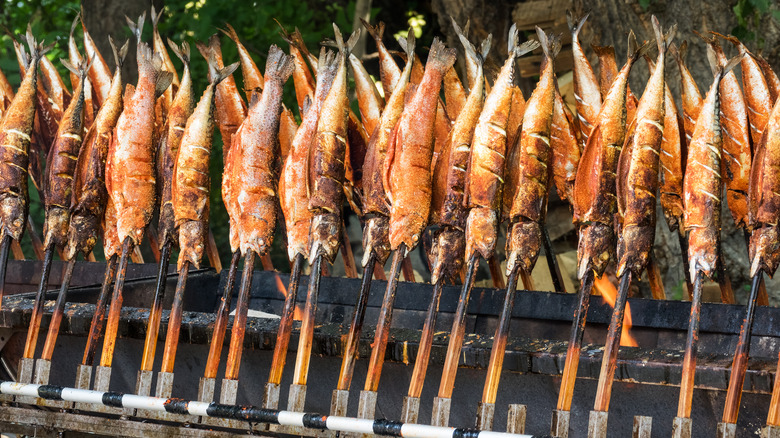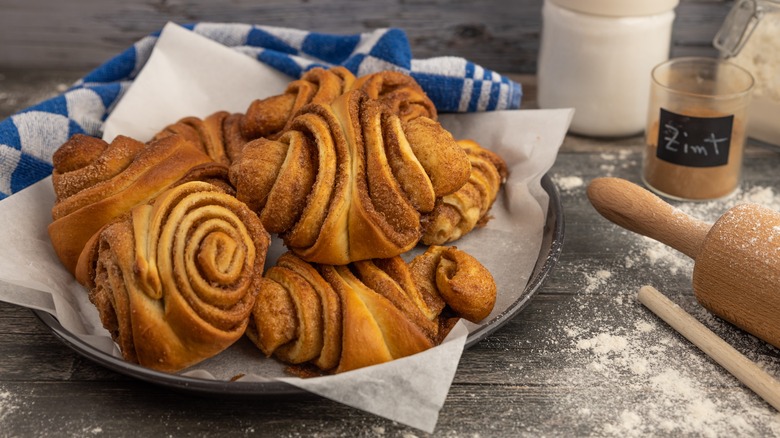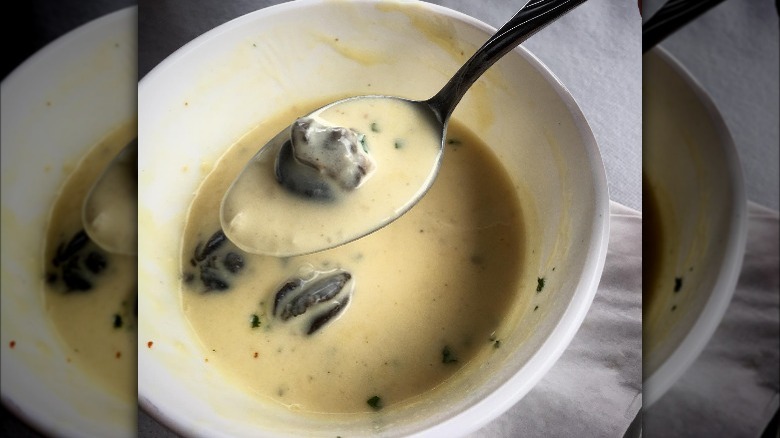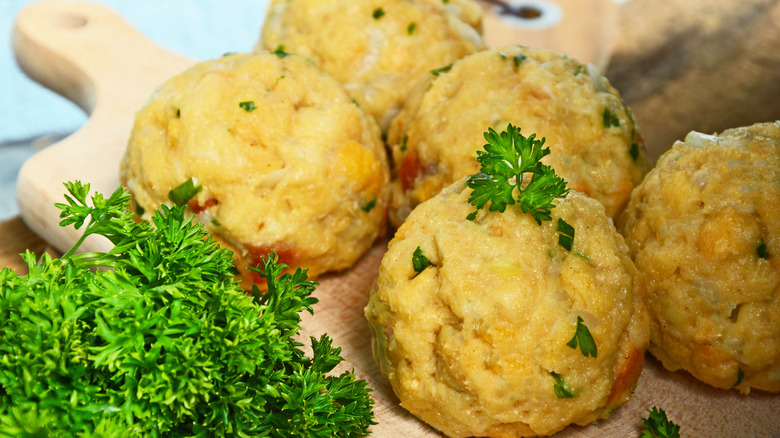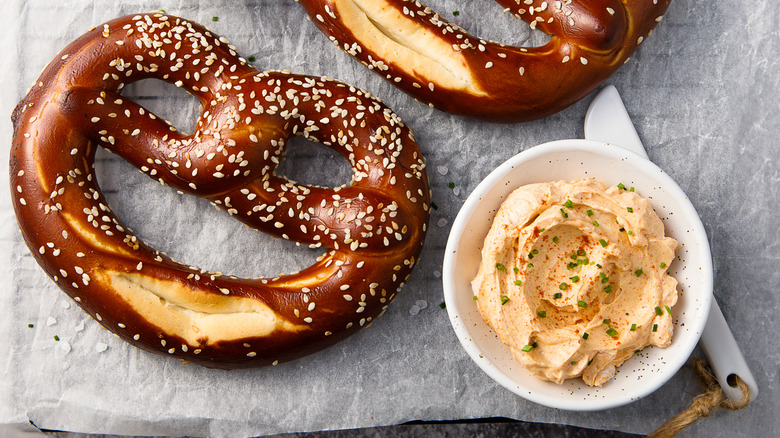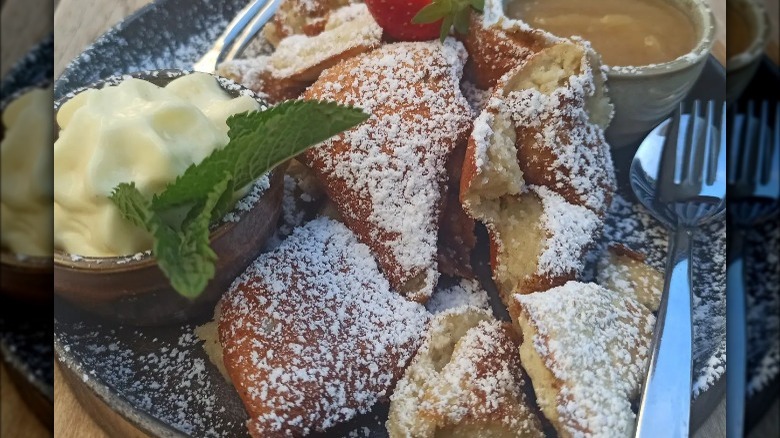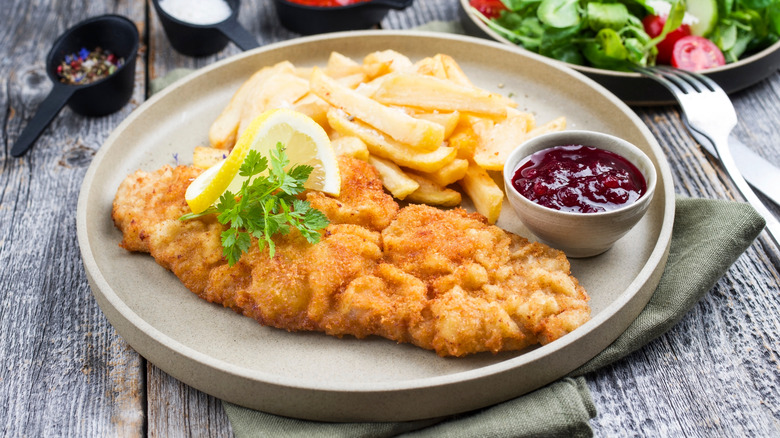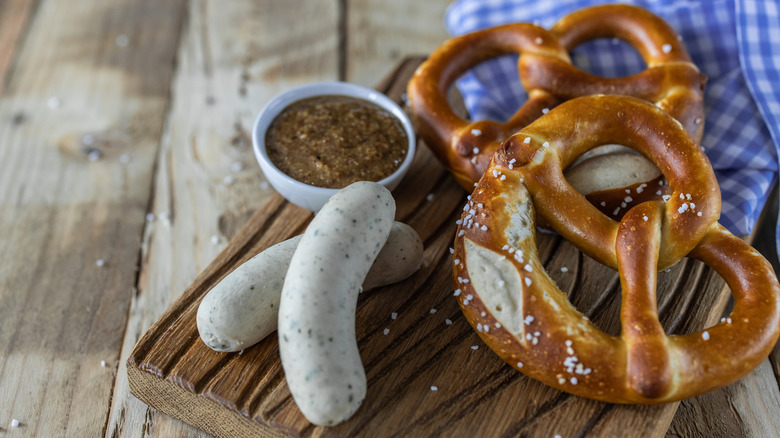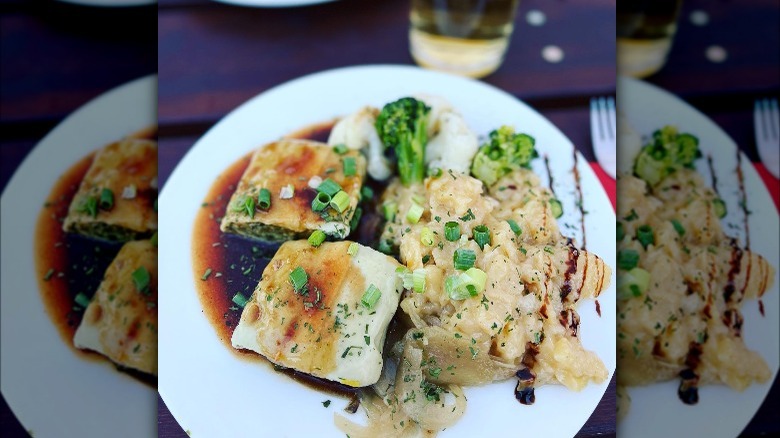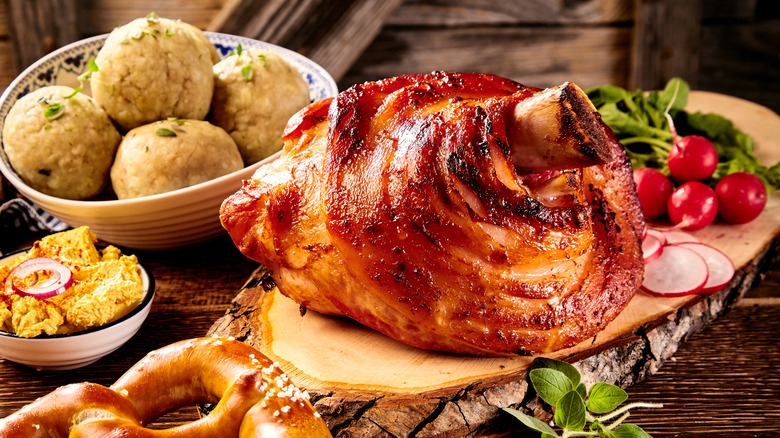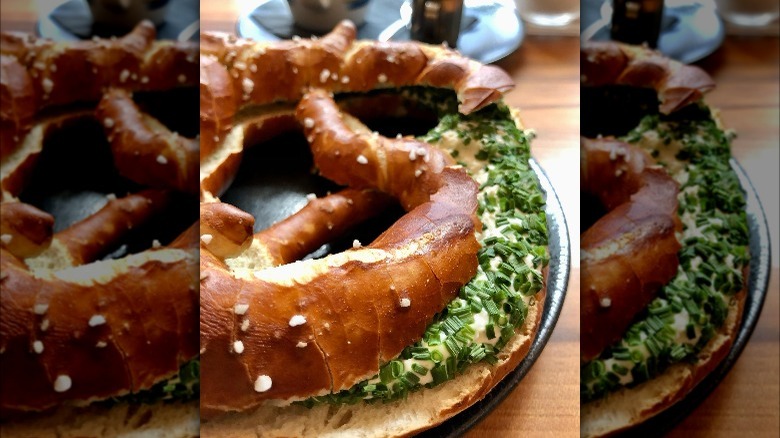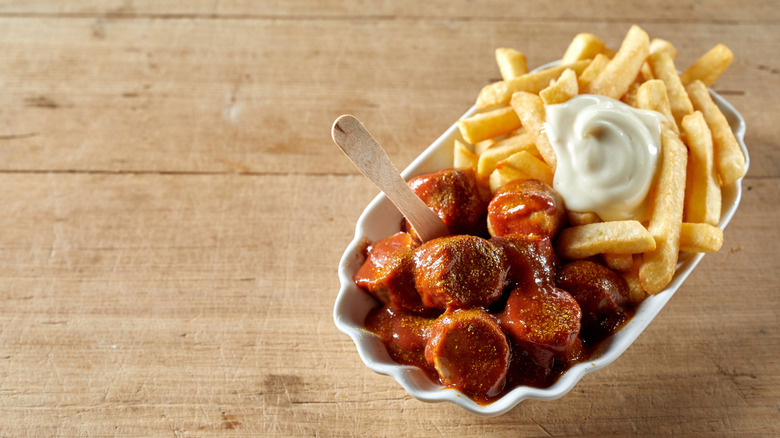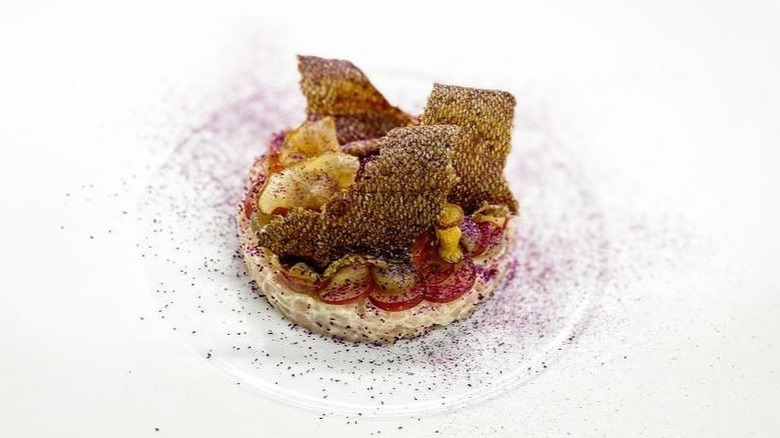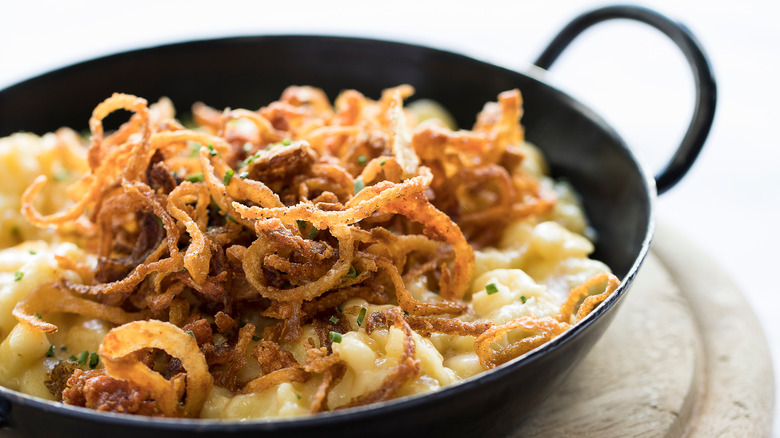16 Iconic German Foods To Try Before You Die
We may receive a commission on purchases made from links.
Germany gets a bad rep for boring food. Who doesn't crinkle their nose at the thought of bland potatoes and sweaty meats? But really this Central European country has much to offer in the way of food. Many dishes like Kaiserschmarrn and Currywurst stay on the tongue of Germans and internationals alike (and that's not just because they're hard to pronounce).
Contemporary German cuisine is heavily influenced by the period following World War II when the country was entirely politically and economically restructured. Many, like those at Deutsche Welle, assert that there was a cultural reaction to the demise of Hitler's regime as well. German food adjusted as a way to achieve some distance from the scars of the past.
This isn't to say there haven't been major outside influences on German cuisine; Jewish, Polish, French, and later Turkish and Italian food sensibilities came to add to the country's pot. Cities have also come to play a role in the national cuisine. Berlin especially acts as a major leader and melting pot of multicultural and innovative food sensibilities. That being said, even to this day, German cuisine is highly regional; different dishes can be found in different parts of the country. Suffice to say, there's a lot going on with German food beyond the stereotype. Here are 16 iconic German foods that deserve a second glance, and a second bite.
Döner kebab
There's no better entry point into contemporary German cuisine than this Berlin native: the döner kebab. This aromatic sandwich is available on just about any block and almost at all hours of the day (and night). A döner kebab consists traditionally of thinly sliced beef from a spit that is topped then topped with salad, spices, and dressings, all made to taste. As pointed out by The Culture Trip, döner is a street meat comparable to gyros or shawarma.
The kebab is credited to two entrepreneurs, Kadir and Mehmet, who came to Germany from Turkey during the massive immigration waves of the '60s and '70s (via the BBC). While The Culture Trip points to other alleged inventors, it's safe to say the kebab was by all means ripe to enter the reforming country. Nowadays, despite its relatively cheap price, the entire kebab industry is, according to the BBC, in the multi-billions. Turkish-Germans remain a large and important part of the culture, and the döner kebab remains a cornerstone of what defines German food nowadays.
Döner is, if anything, heavy. It pairs perfectly with a light and refreshing drink. The great news is that another German drink makes a great partner for the indulgent sandwich. Spezi is a thrilling combination of cola and orange soda. While some Americans might describe it as "swamp juice," this soda's sweet and citrusy finish offers a nice cleanse to the filling snack.
Steckerlfisch (fish on a stick)
Fish isn't probably what comes to mind when thinking of the primarily landlocked Germany. But the country's many streams, lakes, and North Coast offer some options for those who prefer food that swims. Steckerlfisch, or as Absolute Munich calls it "grilled fish on a stick", is a Bavarian delight that roughly translates to fish on a little stake. An Oktoberfest favorite, though it can be found yearly at beer gardens, steckerlfisch was once primarily locally made from local freshwater fish, but nowadays is by and large made from the oceanic mackerel (via Munich City Guide). Some die-hard fans maintain that it's worthwhile to seek out a smaller beer garden or restaurant to find freshwater steckerlfisch.
No matter the type of fish used, the method remains the same. The fish is staked, of course, and then slow-cooked over a coal fire. The fish are rested in a way that allows the oil to run down the body of the fish instead of into the fire. This makes for an especially flavorful, smokey, and oily fish. In short, a flakey yet rich delight. While Absolute Munich maintains, somewhat begrudgingly, that steckerlfisch can be eaten with a fork and knife, it asserts that this smoked good works best as a finger food. And what better place to wash down a finger-lickin' meal with a nice Bavarian beer?
Franzbrötchen
On the other side of the country and taste spectrum is northern Germany's franzbrötchen. In the sea of bread that fills the country, Hamburg's franzbrötchen stands out. For those that have never heard of this more obscure European pastry, Atlas Obscura recommends imagining a crushed croissant. Here's a good time to make note that franzbrötchen's are more than a tad heavier than a croissant. These pastries are, per Taste Atlas, made from flour, butter, yeast, and most importantly, cinnamon and sugar. The cinnamon is really the defining characteristic of this pastry besides its unique shape.
The history behind the franzbrötchen, whose name roughly translates "French roll", is a bit murky and ranges from banal to rebellious. Taste Atlas says that one theory surrounding the bread's genesis is simply of a Hamburg baker adding butter to an existing Franzbrot, or French bread, recipe. A bit more daringly, the site also suggests that some believe that Hamburg chefs would purposefully bake croissant orders incorrectly during the French occupation of the city.
Nowadays, the bread has become a staple and defining characteristic of Hamburg, though it's becoming more and more popular across Germany. Slight variations to the recipe can include pumpkin seeds and chocolate. No matter the recipe, as Taste Atlas notes, the franzbrötchen makes a great companion to coffee.
Schneckensuppe (snail soup)
France might be the first place that comes to mind when you think about eating snails, but Germany has also been known to indulge in the slimy snack. Schneckensuppe, also known as snail soup, can be found in the Black Forest region of Germany. In fact, WebMD goes so far as to name it a "delicacy" in the country's cuisine. For those who might be more hesitant when it comes to indulging in these slimy creatures, WebMD encourages those who can overcome the mental block to give it a good shot. As the site notes, snails have an incredibly unique texture, moistness, and ability to take on the best of whatever sauce they're cooked into. Thus, soup seems to be the perfect playing ground for these mollusks.
As Taste Atlas describes, schneckensuppe is a hearty soup made by combining heavy cream, white wine, garlic, butter, and a collection of different varieties of snail. To prepare the soup by hand, Taste Atlas recommends cooking the snails in butter first, presumably for flavor and texture. The soup is clearly a rich endeavor. As the website notes, snail soup, whether cooked at home or ordered in a restaurant, should be served very hot and come with a little bread on the side.
Semmelknödel
Semmelknödel are described by Taste Atlas as a sort of German, but more accurately Bavarian, bread dumpling. They can be found in varying sizes, but will always be served in a distinctly round shape. There are also many different varieties of semmelknödel, mainly because their bread base is so neutral. In fact, spices and flavorings are necessary to make this filling dumpling flavorful. Tintorera points out that semmelknödel are sort of like rolled-up balls of stuffing, and with that line of thinking semmelknödel dipped in graving might just be a candidate for the Thanksgiving table.
Vegetarians do take caution — as stated above, semmelknödel are made with a wide variety of flavors and ingredients. While some dumplings are vegetarian, others may have beef or pork cooked into them. In any case, make sure to ask before enjoying.
That being said, there are no bounds to enjoying semmelknödel should you wish. There's something extremely autumnal to the bread dumpling, maybe because it fills you up to a point of coziness. Taste Atlas recommends savory mixes of semmelknödel served alongside meaty dishes or drenched in a creamy mushroom sauce. Tintorera points, however, towards the ever-seductive road less traveled and names applesauce as a worthy pair to the semmelknödel.
Obatzda
Buttery cream cheese? Don't mind if we do! Obatzda's name means "mixed one" or "pressed one" (via I Like Germany). The translation is a hint to the method that goes into the madness of the light orange spread. According to the site, cheese used to be an extremely expensive commodity in Germany. This led to a lot of innovation in the kitchen to ensure that no bit of the pricey cheese would go to waste. One such method of cheese preservation was mixing, or pressing, soft cheese in with butter, chives, spices, and other seasonings. Thus, obatzda was born and allegedly reached popularity by the '20s.
Wordsense offers a more specific description of this food and defines obatzda as three parts camembert, aged Romadur raw cow's milk cheese, and butter. The site also notes garlic, horseradish, and caraway seed as welcome additions to a great mix. I Like Germany notes that the cheese spread is often eagerly eaten at dinner with pretzels. While they certainly make a winning combination, obatzda can make just as much a splash as a breakfast spread, snack, or charcuterie board addition.
Kaiserschmarrn
Kaiserschmarrn, whose name delightfully translates to "emperor's mess," is technically an import from Austria, where it was especially cherished by the Jewish community (via the Leo Baeck Institute). Although the dessert is Austrian in origin, it has long been cherished in southern Germany, which shares a border with Austria. While it may look like a moist funnel cake, the dessert is best, and often, described as a sort of spongey pancake (via The Local). Kaiserschmarrn is made out of milk, eggs, flour, sugar, salt, and raisins. The mixture is then either fried or baked in butter to really give the mix an extra layer of indulgence and bring everything to a beautiful golden brown.
While kaiserschmarrn is traditionally served around the holidays, it can be found at traditional German restaurants like the one noted by The Local. Once ready to eat, the scrambled pancakes are often doused in a healthy amount of powdered sugar and served topped with a variety of sauces, be it apple sauce, vanilla sauce, or a local plum compote like pictured above. As the Leo Baeck Insitute cheekily suggests, ice cream makes just as wonderful an addition to the emperor's mess.
wiener schnitzel
Another Austrian import, the name "wiener schnitzel" literally translates to "Viennese cutlet" and alludes to the popularity of this dish in the Germanic sphere. It's widely believed that schnitzel drew inspiration from an Italian dish of the same nature (via Visiting Vienna and Cooks Info). Par Taste summarizes Schnitzel as a tenderized cutlet that is coated in breading and fried to a golden brown. Tenderness is really the key to a good schnitzel. Traditionally each slice of meat is pounded almost completely flat to achieve its characteristic texture and shape.
As the Par Taste article observes, there isn't a "typical" Schnitzel meat, though pork tends to reign supreme in Germany. The major exception is, however, wiener schnitzel, which is made with veal. An extremely traditional dish, wiener schnitzel is sure to hit all the right notes. Often accompanied with a wedge of lemon, lingonberry jam, and a starchy side, the veal always steals the show. When ordering, make sure to order wiener schnitzel and not schnitzel wiener art, as the former is the O.G. dish and the latter is pork prepared in the style of it.
Weisswurst
Another Oktoberfest classic, weisswurst is the typical breakfast preceding a day at the world's most cherished beer festival. weisswurst literally means "white sausage", which is self-explanatory. While it's generally advisable to not ask too many questions about what goes into a sausage, it is good to know that this traditional sausage is a mix of both veal and pork (via The Munich Eye).
The sausage is usually served up two at a time with a pretzel and a bit of a sweet mustard that really adds a zing to the dish. Don't be surprised when ordering weisswurst that a pot of warm water with two links comes to the table. As noted by The Munich Eye, these sausages are made in an incredibly thin casing which means they can only be boiled. Make sure, however, to peel off this casing before eating, in fact, that the telltale sign of a high-quality weisswurst is if it peels easily.
Weisswurst is almost strictly a breakfast food, and most restaurants will not serve weisswurst past 11 (via Bavarian News). There's one more culture shock to the dish: The final component of the weisswurst breakfast is the weissbier or German wheat beer. Sure, it might be an intense start to the day, but for those heading over to Oktoberfest, there's no better way to get the ball rolling.
Maultaschen
No, it's not ravioli, though it may look like it. Maultaschen are pocket-sized pasta pouches filled with pork, spinach, and onions, and typically drenched in a light sauce (via Educalingo). It's not uncommon for there to be a lot of individual variation on the maultaschen's filling. The Local also observes that the filled goodies can also be fried in a pan or topped with an egg to add different textures and elements to the dish.
Maultaschen are believed to come from Swabia in Southwest Germany. Their origin is even in a protected class, per The Local. The classification means that similar to how real Champagne needs to come from the Champagne region of France, maultaschen need to be produced in Swabia to be considered "real".
But just because they need to be made in Swabia, doesn't mean they are only popular there. In fact, it's just about the opposite. The Local speaks of maultaschen sweeping the Northern parts of the country. One German astronaut even requested them in space, It's safe to say their reach is enormous at the moment. The good news for vegetarians and vegans who might be feeling disheartened from this meat-heavy-list is that vegan and vegetarian maultaschen have become steadily more available. Perhaps when visiting a traditional German restaurant, there might be more to order than a simple plate of fries.
Schweinshaxe
Easily the more divisive item on the menu, the schweinshaxe, or pig knuckle, is simply impossible to ignore. It's hard for many to look at the bone on the plate, surrounded by a thick layer of meat, and say "Yum! Time to dig in." But, per Absolute Munich, this is also one of the most beloved dishes in Germany, and for good reason. The publication clarifies that the dish isn't actually the pork knuckle, but rather pork shank. While there are some regional variations on the pork knuckle, there's a reason why this dish is a cornerstone of Bavarian cuisine.
Typically, Bavarian recipes make sure to give the shank a good spice rub, usually featuring caraway seeds that are very prevalent in German cuisine. Good Schweinshaxe should be tender and aromatic and practically falling off the bone. The outside of the Schweinshaxe should be crackling-crisp, and the meat gets more tender the deeper you dig in. Taste Atlas says that you can eyeball good pig knuckle: It should simply look"golden. When served, they often come with sauerkraut, potatoes, or potato dumplings.
(Butter)brezel
Pretzels are arguably the German bread; even those who aren't familiar with the country are familiar with twisted delight. Funnily enough, it's actually been disputed whether these knotted breads are actually from Germany originally. Some say that pretzels got their start in Italy or even Southern France, but what's stayed consistent is the pretzel's meaning in Christianity (via Pretzels). It's thought that the pretzels once represented hands in prayer or the Holy Trinity. The ingredients used to make pretzels were also typically Lent-friendly to provide Catholics with a filling solution during their fasting periods, and pretzels were even once used like Easter eggs during the holiday. It's easy to see how this bread took over the historically Christian country.
Nowadays, pretzels still feed the country, no matter how much has changed. Contemporarily, a butterbrezel, or buttered pretzel, is a halved pretzel with a generous butter spread adhering the two halves together (via Par Taste). Sometimes chives are added to give the pretzel an added burst of flavor. According to the site, nowadays, the most common German pretzel is the lye pretzel, which also enjoys international fame. Its trademark brown exterior sprinkled with salt comes as a delight to many. A pre-bake dip in lye (sodium hydroxide) gives the pretzel its one-of-a-kind sheen and crunch.
Currywurst
Another hallmark of the Berlin street meat scene, currywurst is worth digging into. As The New York Times asserts, the currywurst is full of contradictions. It's made of traditional German sausage, doused in a ketchup blend, and sprinkled with curry powder. The dish's smell and appearance can not be mistaken for anything else. This dish could really only come about in a city as sprawling and cosmopolitan as Berlin.
Introduced after the Second World War during major food shortages, the sausage has come to symbolize not only survival and creativity, but also the endurance of both Berlin and Germany (via Reuters). The dish itself is financially accessible — it usually clocks in at under a few Euros a pop. Many also argue that the currywurst is a major symbol of solidarity. Whether rich or poor, Berliner or not, the crispy sausage provides both sustenance and comfort (via NPR). The dish always includes a good portion of fries and the European favorite dipping sauce: mayonnaise. When digging and dipping into this dish, one not only has the opportunity to experience Germany's past, but also its present, and probably its future.
Schwarzwaldforelle (Black Forest trout)
The Black Forest region may be better known for Black Forest cake, but sites like Seafood Source go so far as to say that those who are only eating ham and cake in the Black Forest are missing out! Schwarzwaldforelle, or Black Forest trout, refers to black or rainbow trout from the mountainous regions of Southwestern Germany (via Taste Atlas). The Black Forest trout is notable for its unique flavor profile, and Taste Atlas credits the frigid alpine streams where the fish lives for its distinct taste. The fish is, as per the site, both aromatic and firm, all of which has cemented it as a staple in the region.
Per Seafood Source, it's very likely that any Black Forest trout you eat has been cultivated and raised in an aquaculture farm. This is partially due to the fact that the region has optimal climate conditions for fish farming. Black Forest trout can be enjoyed in any number of ways, from smoked to grilled, marinated or barbecued, even as a minimalist tartare. Don't forget the skin, either. As Taste Atlas notes, Black Forest trout skin is a delicacy in itself.
Käsespätzle
Käsespätzle is both a mouthful and a spoonful. Spätzle is, according to Taste Atlas, a completely German pasta that almost looks like scrambled eggs. These noodles are incredibly thick and soft. MasterClass even describes the noodle's texture as "dumpling-like." Suffice to say, this dish is pure comfort food and easy to chow down on.
One of the most popular toppings for these noodles is a healthy helping of cheese, hence käsespätzle or cheese spätzle. While maybe the American favorite mac and cheese comes to mind, there are a few key differences. For one, as probably can be inferred, the noodles in a cheese spätzle are going to leave a much different texture and chew to them than good ole' mac. MasterClass also asserts that cheese spätzle is more casserole-like in nature. It's often topped with fried onions to add a bit of crunch to the otherwise purely ooey and gooey venture. While käsespätzle might not have gotten its foothold in the United States yet, it may be high time to add a German twist to the already wide-ranging and lustrous comfort food landscape of the States.
